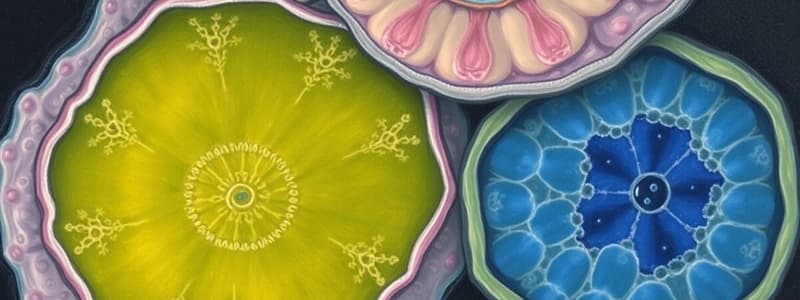Podcast
Questions and Answers
Which of the following is a key difference in energy production strategy between plant and animal cells?
Which of the following is a key difference in energy production strategy between plant and animal cells?
- Animal cells can produce ATP from sunlight directly, whereas plant cells cannot.
- Plant cells use cellular respiration, while animal cells use photosynthesis.
- Plant cells use chloroplasts to produce glucose, which is then used by mitochondria, whereas animal cells obtain energy directly through mitochondria. (correct)
- Animal cells use mitochondria, while plant cells rely solely on chloroplasts.
A scientist is examining an unknown cell under a microscope and observes a rigid outer layer. Which type(s) of cell could it be?
A scientist is examining an unknown cell under a microscope and observes a rigid outer layer. Which type(s) of cell could it be?
- Animal cell
- Plant and fungi cell (correct)
- Animal and fungi cell
- Plant and animal cell
Which statement accurately compares the function of vacuoles in plant and animal cells?
Which statement accurately compares the function of vacuoles in plant and animal cells?
- Neither have vacuoles.
- Both typically have one large vacuole.
- Animal cells have numerous small vacuoles, while plant cells have one large vacuole. (correct)
- Plant cells have numerous small vacuoles, while animal cells have a single large vacuole.
All three cell types (animal, plant, and fungi) share several similarities. Which of the following is present in all three?
All three cell types (animal, plant, and fungi) share several similarities. Which of the following is present in all three?
Which of the following structures is responsible for modifying and distributing proteins within all three cell types (animal, plant, and fungi)?
Which of the following structures is responsible for modifying and distributing proteins within all three cell types (animal, plant, and fungi)?
A researcher discovers a new type of eukaryotic cell. After analysis, it's determined that the cell lacks chloroplasts but possesses a cell wall made of chitin. This cell is most likely similar to which of the following?
A researcher discovers a new type of eukaryotic cell. After analysis, it's determined that the cell lacks chloroplasts but possesses a cell wall made of chitin. This cell is most likely similar to which of the following?
Which cellular structure is responsible for synthesizing proteins in all three cell types: animal, plant, and fungi?
Which cellular structure is responsible for synthesizing proteins in all three cell types: animal, plant, and fungi?
A cell is observed to have multiple nuclei. Which type(s) of cell could this be?
A cell is observed to have multiple nuclei. Which type(s) of cell could this be?
Flashcards
Cell Membrane
Cell Membrane
Encloses the cell, found in plant, animal, and fungi cells.
Cytoplasm
Cytoplasm
Gel-like substance filling cells, containing necessary chemicals.
Nucleus
Nucleus
The control center where DNA is stored, present in plant, animal and fungi.
Ribosomes
Ribosomes
Signup and view all the flashcards
Mitochondria
Mitochondria
Signup and view all the flashcards
Vacuoles
Vacuoles
Signup and view all the flashcards
Endoplasmic Reticulum
Endoplasmic Reticulum
Signup and view all the flashcards
Golgi apparatuses/bodies
Golgi apparatuses/bodies
Signup and view all the flashcards
Study Notes
- Comparing plant, animal, and fungi cells is important for understanding their functions.
Similarities Between Cell Types
- All three cell types (plant, animal, and fungi) have cell membranes that enclose the cell.
- Cytoplasm, a gel-like substance containing chemicals needed by the cell, fills all three cell types.
- All three cell types possess a nucleus where DNA is stored.
- Ribosomes, which build proteins, are present in all three cell types.
- Mitochondria is in all three cell types, and uses oxygen to break down food and release energy.
- Vacuoles, containing food, water, or waste products, exist in all three cell types. However, animal cells usually have many more and much smaller vacuoles.
- Lysosomes are present in all three cell types, although they might have different names depending on the source. In fungi and plants, lysosomes are sometimes called acidic vacuoles.
- Endoplasmic reticulum (rough and smooth), a system of tubes that transports proteins and lipids
- Golgi apparatuses/bodies distribute proteins around the inside and to the outside of the cell.
- All cell types contain a cytoskeleton, vesicles, nucleus, nucleolus, endoplasmic reticulum, ribosomes, a cell membrane, golgi apparatus, mitochondrion and vacuoles.
Differences Between Cell Types
- Plant cells have cell walls made of cellulose for structure, while animal cells do not, and fungal cell walls are composed mainly of glucans, chitin, and glycoproteins.
- Plant cells ALWAYS have only one nucleolus.
- Filamentous fungi can have "multinucleated" cells that stretch over several meters.
- Plant cells have chloroplasts for photosynthesis, unlike animal and fungi cells.
- While all three cell types use mitochondria for ATP production, only plants use chloroplasts for photosynthesis to produce glucose, which mitochondria then uses for cellular respiration.
- Animal cells tend to have many small vacuoles, whereas mature plant cells may have only one large vacuole, and fungi can have many or one.
- Animal cells possess centrioles and lysosomes.
- Plant cells possess chloroplasts, a cell wall and a central vacuole.
Cells and Information
- The Nucleus is a control center of the cell.
- Nucleus contain DNA
- DNA and RNA molecules work together to make proteins. Basic Biology is a good place to find further information on the subject.
- Being able to use a Venn Diagram and hand drawn diagram to explain the subject will be beneficial.
Studying That Suits You
Use AI to generate personalized quizzes and flashcards to suit your learning preferences.




